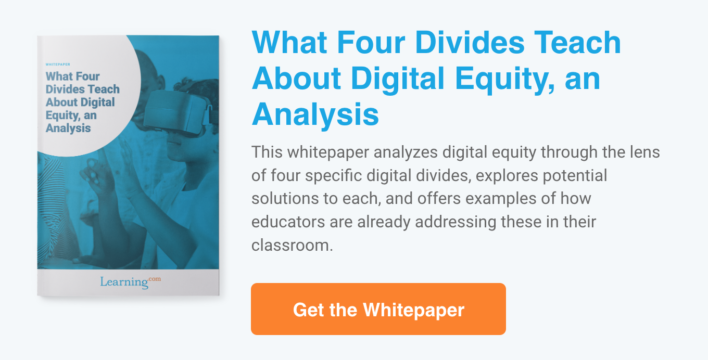This future can entail a lot of things, including:
- Entering the workforce and accessing stable employment.
- Supporting a family and serving as a role model for the next generation.
- Participating as an active citizen and upholding democratic values.
- Welcoming neighbors and investing in the community.
- Recognizing common humanity and participating as a global citizen.
- Collaborating with diverse groups of people to seek solutions to local, national and global problems.
- Sowing bright and sustainable futures for generations to come.
Thus, the purpose of education is not only to benefit the educated by supporting them in all aspects of their life, but also to benefit the community, both local and global.
Of course, this is an idealistic view of education; and the current reality often does not rise to meet it, leaving us to grapple with possible solutions—many of which are founded on digital equity.
What is Digital Equity?
Digital equity refers to the fairness and justice of providing digital education, resources and opportunities to all. Unlike equality which provides the same resources to everyone regardless of their current status, equity acknowledges and makes adjustments for imbalances so that resulting opportunities, not resources, are equal.
Digital equity is an ongoing process, requiring the identification of intentional and unintentional barriers that rise from bias or systemic structures, then works to overcome these barriers to create more equitable opportunities.
The purpose of digital equity, especially in education, is to prevent technology from being a barrier of entry for opportunities including educational opportunities, future careers, communication and social interaction as well as informed and active citizenship.
Without digital equity and inclusion, the predominance of technology becomes a barrier to entry and participation. By working to curb this, digital equity sets out to ensure everyone has the technological capacity to participate in the labor market as empowered employees, partake in educational opportunities, engage positively with others online, and practice informed citizenship.
The process of digital equity is an ongoing one, continually evolving based on the current inputs of bias and systemic structure as well as the education and opportunities that arise from digital literacy.
Why is Digital Equity Important?
The following data illustrates how technology impacts daily experiences:
- Work Life: 99% of Fortune 500 companies use digital applicant tracking system and over 92% of all jobs require digital skills.
- Academic Life: A federal survey found that 70 percent of teachers assign homework online. Many teachers also post grades online, offer feedback to students, answer questions, and address parents through digital platforms.
- Personal Life: 90% of Americans use social media, spending on average two and a half hours per day using it, which means they are building online communities, sharing life updates, and engaging with news and other informational outlets.
- Citizenship: Eight in ten Americans get news from digital devices with 53 percent using social media as a primary news source. Unable to navigate the virality of false or misleading news, three-quarters of Americans overestimate their ability to spot false headlines, and the worse they are at it, the more likely they are to share it.
Final Thoughts
The road to understanding digital equity and the barriers both necessitating and inhibiting it is paved by the circumstances of inequity. In other words, the barriers to digital equity, which are commonly termed divides or digital divides, shape our understanding of it.
While the divides are framed in the context of digital equity, they rarely are purely digital in nature. They are affixed with conditions of inequity and inequality that conform to a modern, digital outlook.
This article was originally published in June 2020 and has since been updated for content, accuracy, and resources.

Learning.com Team
Staff Writers
Founded in 1999, Learning.com provides educators with solutions to prepare their students with critical digital skills. Our web-based curriculum for grades K-12 engages students as they learn keyboarding, online safety, applied productivity tools, computational thinking, coding and more.


